This journal is brought to you by...
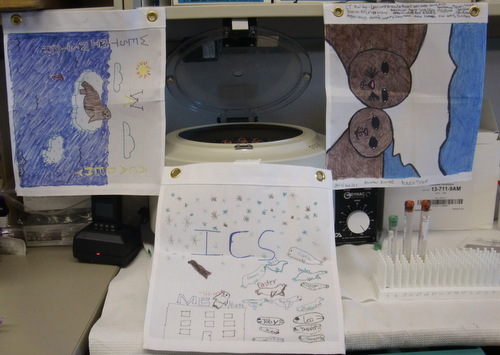
- Sarah Dormis’s and Jennifer Thompson’s 6th grade class at Westminster Academy
- Sue Tony’s 6th graders at St. Philomena
- Mrs. Shadensack’s 7th grade class at Immaculate Conception
Sometimes, things we do not know much about can be scary. Blood, for example, can seem gross or frightening but it’s actually really cool! I bet if we learn a little about the blood of the Weddell seal, you will think it’s cool too. So, here’s the first neat fact about blood. You and I have something in common with the Weddell seal. We all have blood! But, I wonder if the Weddell seal’s blood is like our blood.
Will you help me find out?
Let’s take a look at the parts of blood and the role each part plays. We want to compare and contrast seal blood and human blood. By understanding the differences and the similarities between each type of blood, we can learn more about the Weddell seal.
What’s in blood?
Did you know that blood is made up of lots of different parts? Take a look at the diagram below and see if you can identify the four main components of blood.
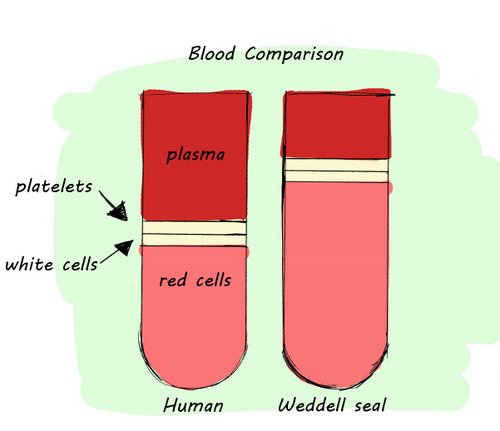
The four main parts of all blood are: red blood cells, white blood cells, platelets and plasma. Each part plays a different role. Let’s take a closer look! Look at the diagram of blood in the test tubes. Do seals and humans have the same things in their blood? Do we have the same amounts of each component in our blood?
You can see that the biggest components of human blood are red blood cells (35-45%) and plasma (50%). White cells and platelets each make up only about 1% of blood. The main difference between seal blood and our blood is the percentage of red blood cells. Seals have a lot more red blood cells. I wonder why?
Let’s look at another picture that compares the size of a seal to an average human adult’s size.
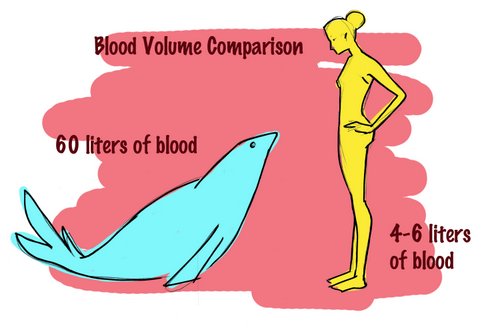
What can we learn from this diagram? Let’s make some observations! The seal appears to be larger than the human. Seals are much larger than you or I. You might expect an animal much larger than a person to have much more blood, but it’s not just because seals have bigger bodies. In our bodies, blood makes up 7-8% of our weight, but in a Weddell seal’s body, blood makes up 20-22% of their body weight.
What else does the diagram tell us? Weddell seals have about 10 times more blood (total volume) in their bodies than an average adult human! Humans have about 4-6 liters of blood as compared to about 60 liters of blood in the much larger seal.
I want to know how much more blood a seal has than me but it’s hard to make a good comparison. We have to find a better way to compare the different amounts of blood. Let’s do some math to figure out how much blood per pound a human has compared to the blood per pound in a seal.
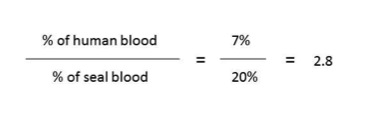
That means Weddell seals have almost 3 times more blood per pound compared to humans. Wow!
So far we know that seals have more red blood cells than us and we know that they have more blood per pound of body weight than us. But how did scientists learn all this? We’ve been taking blood samples on each seal. This is how we collect data to see:
- The total number and size of the red blood cells
- The hematocrit level: the percentage of blood that is made of red blood cells
- The hemoglobin level: the amount of oxygen carrying pigment in the red blood cells
All of these observations we collect for data are quantitative measurements. Quantitative means that we can list our data using a form of measurements. This type of data is really important because measurements allow us to easily compare different samples and run statistics on the data we collect. Statistics can help us find patterns in science that are hard to observe without a little help from math!
Why do these seals need so much blood? Why do they need so many more red blood cells? Let’s do some critical thinking.
- What does blood do in the body? Blood delivers oxygen and nutrients to every part of your body. One of the main jobs of red blood cells is to transport oxygen from the lungs to all the living tissues and organs in an animal’s body.
- What effect would more red blood cells have? More red blood cells mean more oxygen in the blood stream.
- Why would a Weddell seal need more oxygen? Diving!
I bet seals have more blood and more red blood cells to help them on those long dives!
Red blood cell counts and size
We count how many red blood cells the seals have using a hemocytometer and microscope. A hemocytometer is a specially designed slide that allows us to count cells. It contains grids that are designed to hold a specific amount of liquid. By counting the number of red blood cells on this grid, we can determine how many cells there are in a given amount of blood. The microscope helps us see the grid up close so we can do a good job of counting the number of red blood cells. Make some observations of your own. What shape are the blood cells? How many do you count on each grid?
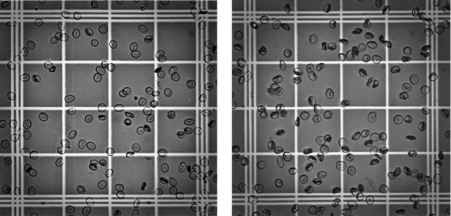
Go to ‘Ask the Team’ and reply to the discussion thread ‘Red Cell Count’ to let me know your answers!
We have measured and counted the number of blood cells, let’s measure hematocrit levels! Hematocrit is the packed volume of red blood cells in your blood. In other words, your hematocrit level tells you how much of your blood is actually made up of the oxygen carrying red blood cells.
Hematocrit = percent volume of red blood cells
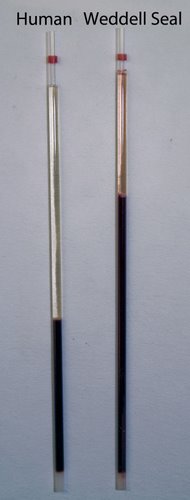
The higher the hematocrit percentage, the more oxygen the seal can carry – and that’s a very good thing! My hematocrit level is about 35.5 – that means 35.5% of my blood is made of red blood cells. The seals we’ve tested have had hematocrit levels ranging between 50-70%. That means almost twice as much of the Weddell seal blood is made up of the oxygen carrying red blood cells.
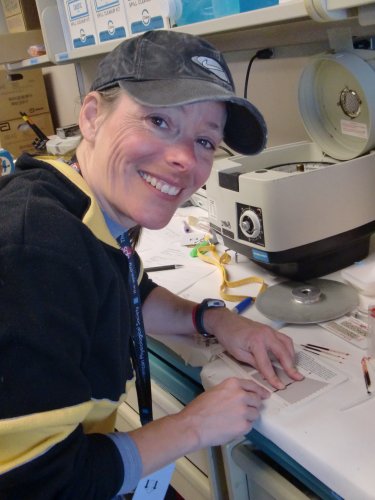
Hemoglobin
Hemoglobin is a special protein in the red blood cells that binds to oxygen and carries it from the lungs to the rest of the body. It then returns carbon dioxide from the body to the lungs so it can be exhaled.
Hemoglobin = oxygen carrier
Who do you think has more hemoglobin? If you guessed Weddell seals, you’re right! My hemoglobin level was 12.3%, but the Weddell seal we measured had 20-28 grams of hemoglobin protein in 100 milliliters of blood (20-28%).
We take a blood sample from every seal that we examine, because, as you can see, the contents of a Weddell seal’s blood can tell us a lot!


Comments